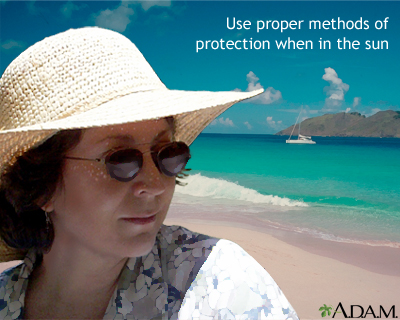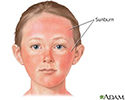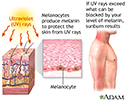Sunburn
Solar erythema; Burn from the sun
A sunburn is reddening of the skin that occurs after you are overexposed to the sun or other ultraviolet light.
Considerations
The first signs of a sunburn may not appear for a few hours. The full effect to your skin may not appear for 24 hours or longer. Possible symptoms include:
- Red, tender skin that is warm to the touch
- Blisters that develop hours to days later
- Severe reactions (sometimes called sun poisoning), including fever, chills, nausea, or rash
- Skin peeling on sunburned areas several days after the sunburn
Symptoms of sunburn are usually temporary. But the damage to skin cells is often permanent, which can have serious long-term effects. These include skin cancer and early aging of the skin. By the time the skin starts to become painful and red, the damage has been done. Pain is worst between 6 to 48 hours after sun exposure.
Causes
Sunburn results when the amount of exposure to the sun or other ultraviolet light source exceeds the ability of melanin to protect the skin. Melanin is the skin's protective coloring (pigment). Sunburn in a very light-skinned person may occur in less than 15 minutes of midday sun exposure, while a dark-skinned person may tolerate the same exposure for hours.
Keep in mind:
- There is no such thing as a "healthy tan." Unprotected sun exposure causes early aging of the skin and skin cancer.
- Sun exposure can cause first- and second-degree burns.
- Skin cancer usually appears in adulthood. But it is caused by sun exposure and sunburns that began as early as childhood.
Factors that make sunburn more likely:
- Infants and children are very sensitive to the burning effects of the sun.
- People with fair skin are more likely to get sunburn. But even dark and black skin can burn and should be protected.
- The sun's rays are strongest during the hours of 10 a.m. to 4 p.m. The sun's rays are also stronger at higher altitudes and lower latitudes (closer to the equator). Reflections off water, sand, or snow can make the sun's burning rays stronger.
- Sun lamps can cause severe sunburn.
- Some medicines (such as the antibiotic doxycycline) can make your skin easier to sunburn.
- Some medical conditions (such as lupus) can make you more sensitive to the sun.
Home Care
If you do get a sunburn:
- Take a cool shower or bath or place clean wet, cool wash cloths on the burn.
- DO NOT use products that contain benzocaine or lidocaine. These can cause allergies in some persons and make the burn worse.
- If there are blisters, dry bandages may help prevent infection.
- If your skin is not blistering, moisturizing cream may be applied to relieve discomfort. DO NOT use butter, petroleum jelly (Vaseline), or other oil-based products. These can block pores so that heat and sweat cannot escape, which can lead to infection. DO NOT pick at or peel away the top part of the blisters.
- Creams with vitamins C and E may help limit damage to skin cells.
- Over-the-counter medicines, such as ibuprofen or acetaminophen, help to relieve pain from sunburn. DO NOT give aspirin to children.
- Cortisone creams may help reduce inflammation.
- Loose cotton clothing should be worn.
- Drink lots of water.
Ways to prevent sunburn include:
- Use a broad-spectrum sunscreen of SPF 30 or higher. A broad-spectrum sunscreen protects from both UVB and UVA rays.
- Apply a generous amount of sunscreen to fully cover exposed skin. Reapply sunscreen every 2 hours or as often as the label says.
- Reapply sunscreen after swimming or sweating and even when it is cloudy.
- Use a lip balm with sunscreen.
- Wear a hat with a wide brim and other protective clothing. Light-colored clothing reflects the sun most effectively.
- Stay out of the sun during hours when the sun's rays are strongest between 10 a.m. and 4 p.m.
- Wear sunglasses with UV protection.
When to Contact a Medical Professional
Call a health care provider right away if you have a fever with sunburn. Also call if there are signs of shock, heat exhaustion, dehydration, or other serious reactions. These signs include:
- Feeling faint or dizzy
- Rapid pulse or rapid breathing
- Extreme thirst, no urine output, or sunken eyes
- Pale, clammy, or cool skin
- Nausea, fever, chills, or rash
- Your eyes hurt and are sensitive to light
- Severe, painful blisters
What to Expect at Your Office Visit
The provider will perform a physical exam and look at your skin. You may be asked about your medical history and current symptoms, including:
- When did the sunburn occur?
- How often do you get sunburn?
- Do you have blisters?
- How much of the body was sunburned?
- What medicines do you take?
- Do you use a sunblock or sunscreen? What type? How strong?
- What other symptoms do you have?
References
American Academy of Dermatology website. Sunscreen FAQs. www.aad.org/public/everyday-care/sun-protection/sunscreen-patients/sunscreen-faqs. Accessed July 22, 2021.
Dinulos JGH. Light-related diseases and disorders of pigmentation. In: Dinulos JGH, ed. Habif's Clinical Dermatology. 7th ed. Philadelphia, PA: Elsevier; 2021:chap 19.
Sherman KS. Sunburn. In: Kellerman RD, Rakel DP, eds. Conn's Current Therapy 2021. Philadelphia, PA: Elsevier; 2021:1081-1083.
Burns - illustration
Burns
illustration
Sun protection - illustration
Sun protection
illustration
Skin cancer, melanoma on the fingernail - illustration
Skin cancer, melanoma on the fingernail
illustration
Skin cancer, close-up of lentigo maligna melanoma - illustration
Skin cancer, close-up of lentigo maligna melanoma
illustration
Skin cancer - close-up of level III melanoma - illustration
Skin cancer - close-up of level III melanoma
illustration
Skin cancer - close-up of level IV melanoma - illustration
Skin cancer - close-up of level IV melanoma
illustration
Skin cancer - melanoma superficial spreading - illustration
Skin cancer - melanoma superficial spreading
illustration
Sunburn - illustration
Sunburn
illustration
Sunburn - illustration
Sunburn
illustration
Burns - illustration
Burns
illustration
Sun protection - illustration
Sun protection
illustration
Skin cancer, melanoma on the fingernail - illustration
Skin cancer, melanoma on the fingernail
illustration
Skin cancer, close-up of lentigo maligna melanoma - illustration
Skin cancer, close-up of lentigo maligna melanoma
illustration
Skin cancer - close-up of level III melanoma - illustration
Skin cancer - close-up of level III melanoma
illustration
Skin cancer - close-up of level IV melanoma - illustration
Skin cancer - close-up of level IV melanoma
illustration
Skin cancer - melanoma superficial spreading - illustration
Skin cancer - melanoma superficial spreading
illustration
Sunburn - illustration
Sunburn
illustration
Sunburn - illustration
Sunburn
illustration
Review Date: 6/19/2021
Reviewed By: Ramin Fathi, MD, FAAD, Director, Phoenix Surgical Dermatology Group, Phoenix, AZ. Also reviewed by David Zieve, MD, MHA, Medical Director, Brenda Conaway, Editorial Director, and the A.D.A.M. Editorial team.




















